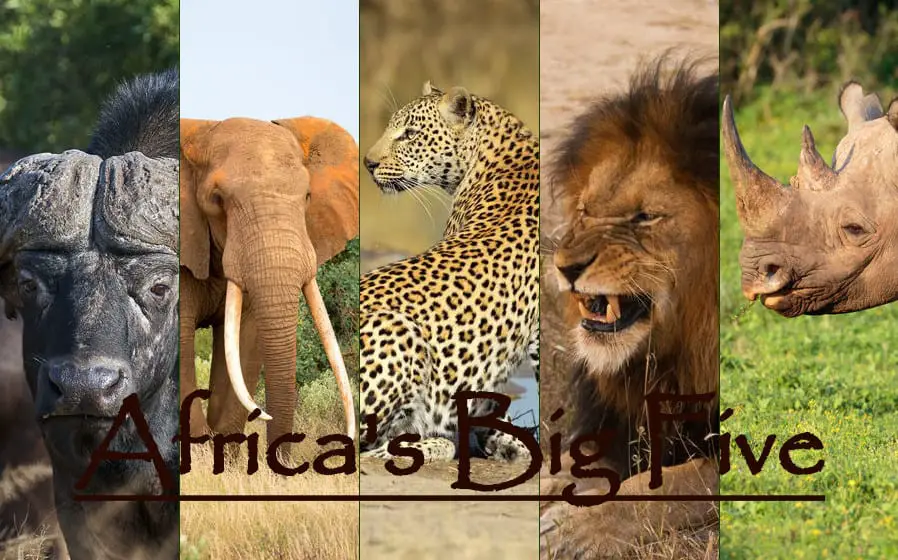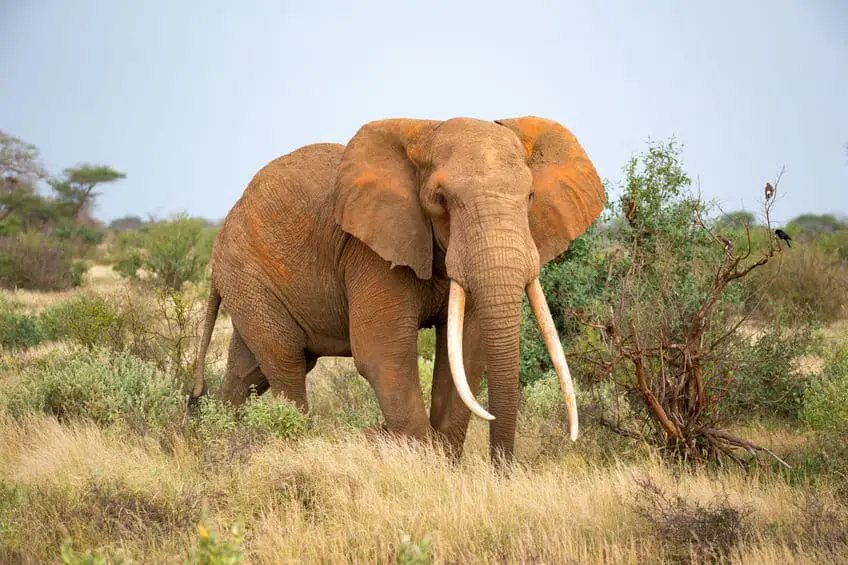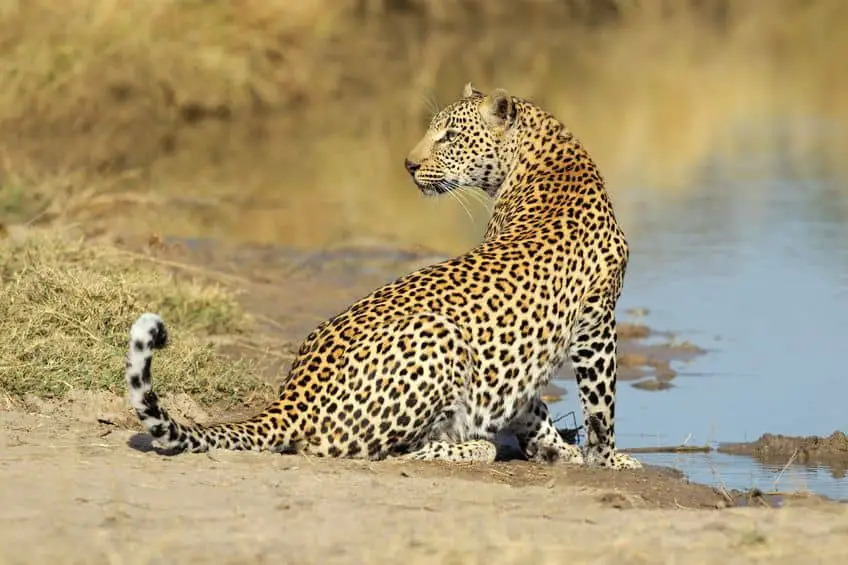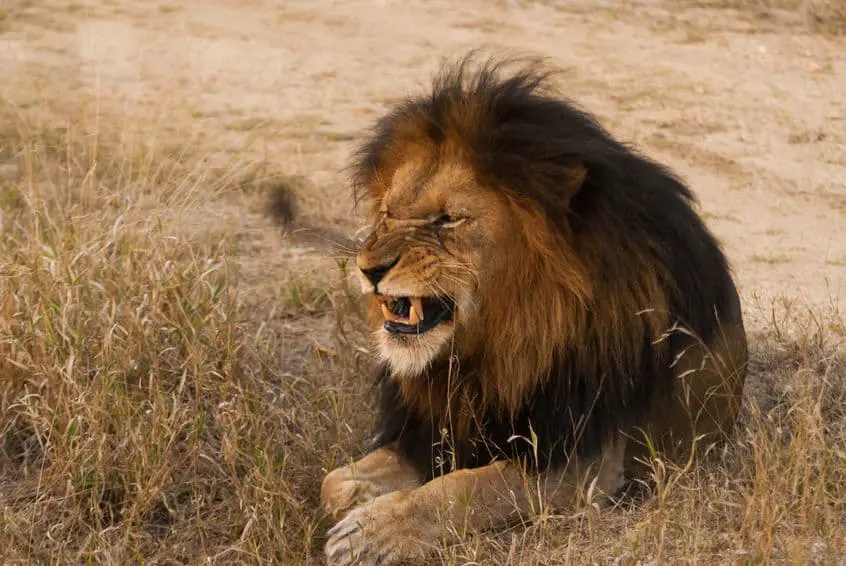
Seeing all members of the big five is the ultimate goal for thousands of safari tourists every year and that is for a very good reason. The big five is a group of five of the most well-known and characteristic animals in Africa and they are all fascinating, beautiful, and majestic in their own ways.
The five members of the Big Five are the Cape buffalo, the African elephant, the leopard, the lion, and the black rhinoceros.
The big five were initially named so for being the five most dangerous and prestigious animals in Africa to hunt on foot but today, they are mostly associated with safaris.
This post contains tons of facts and fascinating information about each member of Africa’s big five.
Cape Buffalo – Syncerus caffer

Said to be the most dangerous member of the big five and often referred to as Black Death, the Cape buffalo, sometimes called the African buffalo, is a very large, aggressive, and extremely strong mammal that is rumored to be responsible for around 200 human deaths per year. Many sources claim that this is more than any of the other big five animals. Most of these victims are big-game hunters who are hoping to bring home a trophy.
Cape buffalos are well-known for their aggressive and unpredictable personality but at a safe distance and under safe conditions, they are truly beautiful, fascinating, and awe-inspiring creatures.
Below is a list of facts about Cape buffalos followed by an in-depth description of the animal.
Cape Buffalo Facts
| Scientific name | Syncerus caffer |
| Family | Bovidae |
| Lifespan | In nature: 20 years In captivity: 29 years |
| Solitary or social | Mostly social |
| Group name | Herd |
| Group size | Usually 15 to 20 but up to 3,000 |
| Weight | Males: 1,100 to 2,000 lb (about 500 to 900 kg) Females: 770 to 1,365 lb (about 350 to 620 kg) |
| Height | Males: Up to 5.75 ft (175 cm) Females: Up to 4.9 ft (150 cm) |
| Length (head and body) | 5.6 to 11.2 ft (1.7 to 3.4 m) |
| Length (tail) | 2.3 to 3.6 ft (70 to 110 cm) |
| Top speed | 35 mph (56 km/h) |
| Primary food | Grass |
| Where in Africa | Most of sub-Saharan Africa |
| Habitat | Savanna, grassland, shrubland, wetlands, and forest |
| Natural enemies | Lions |
| Conservation status | Near Threatened (according to IUCN) |
| Population in Africa | 398,000 to 401,000 (according to IUCN) |
| Gestation period | 11 to 11.5 months |
| Weight at birth | 66 to 132 lb (30 to 60 kg) |
| Height at birth | 20 to 26 in (50 to 66 cm) |
| Number of offspring | 1 |
Cape buffalos can be seen in most of sub-Saharan Africa and can thrive in many types of habitat as long as they have a source of water nearby them at all times.
Female Cape buffalos (called cows) have a gestation period of 11 to 11.5 months after which they give birth to a single calf that weighs between 66 and 132 pounds (30 to 60 kg) but quickly grows to become one of the largest and strongest mammals of Africa
Cape buffalos are highly social creatures that are most often seen in herds. Herds of Cape buffalos usually consist of around 15 to 20 animals, most of which are females that are related to each other, some calves, and a smaller group of males.
Sometimes, Cape buffalos come together and form giant herds consisting of several thousand animals which is an incredible thing to see. But these giant herds are temporary and mostly occur during mating season or for long walks. During the dry season, it is rare to see these massive herds of Cape buffalos since their primary source of food which is grass becomes less bountiful, making it more difficult for the Cape buffalos to find areas that can support thousands of animals.
In the wild, Cape buffalos have a rather long lifespan of 20 years in Africa but the average life expectancy is just 11 years as they often fall victim to diseases or natural enemies.
Cape buffalos do not have many natural enemies. Not only are they very large and extremely strong animals but they are also very protective of each other and will often make sure that the young, old, or otherwise weaker members of their herd are kept safely behind the stronger ones in the event of an attack by predators. Because despite being large, strong, and dangerous, they do have some natural enemies and Cape buffalos are for instance often hunted by lions.
On their own, a lion will rarely be able to take down a Cape buffalo but since lions mostly hunt as groups (called prides), they can actually hunt and kill very large mammals including Cape buffalos. Lions will also often attempt to separate a weak Cape buffalo from its herd and then attack it once it has become sufficiently isolated from the rest of its herd.
In some areas of Africa, Cape buffalos actually make up a majority of lions’ food.
Cape buffalos are not at all easy targets for lions, however, and will almost always kill a lion if the lion is on its own. Hunting Cape buffalos is an extremely dangerous thing to do even for lions that hunt together and will often result in at least one, if not several, of the lions getting hurt.
Cape buffalos are categorized as Near Threatened according to IUCN and the number of Cape buffalos in the wild is declining at a rapid rate. There are currently thought to be around 400.000 Cape buffalos left in the wild in Africa.
If you want to learn more about Cape buffalos, you can head over to this page (link opens in a new tab) where you can see all our posts about them.
African Elephant – Loxodonta africana

The African elephant is the world’s largest land-living animal. They have massive bodies, thick legs, large tusks, and large ears. Everything on an African elephant is large, from the canine teeth which can weigh upwards of 9 pounds each (around 4 kg) to the heart which can weigh 62 pounds (around 28 kg).
African elephants are well-known by their very large ears (which are much larger than on their Indian cousins) which they use to cool themselves down and intimidate enemies, their massive tusks which are used for defense and digging for water, and their long trunks which they use for breaking leaves and branches off trees to eat.
African elephant facts
| Scientific name | Loxodonta africana |
| Family | Elephantidae |
| Lifespan | In nature: 70 years In captivity: 17 years |
| Solitary or social | Mostly social |
| Group name | Herd |
| Group size | 10 to 12 |
| Weight | Male: 8,800 to 14,300 lb (about 4,000 to 6,500 kg) Female: 4,850 to 7,700 lb (about 2,200 to 3,500 kg) |
| Height | Male: 9.8 to 13.1 ft (3 to 4 m) Female: 7.9 to 11.2 ft (2.4 to 3.4 m) |
| Length (head and body) | 16 to 24 ft (4.9 to 7.3 m) |
| Length (tail) | 3.3 to 5 ft (1 to 1.5 m) |
| Top speed | 25 mph (40 km/h) |
| Primary food | Plants. Branches, grass, bark, berries, fruits, and similar |
| Where in Africa | Most of sub-Saharan Africa |
| Habitat | Savanna and desert |
| Natural enemies | Lions, hyenas, wild dogs, and crocodiles |
| Conservation status | Vulnerable (according to IUCN) |
| Population in Africa | 415,000 (according to WWF) |
| Gestation period | 21 to 22 months |
| Weight at birth | 200 to 265 lb (90 to 120 kg) |
| Height at birth | 3 ft (1 m) |
| Number of offspring | 1 |
African elephants can be found in most sub-Saharan countries. They are very adaptable animals who can live in many different types of habitat including savanna, forest, grassland, shrubland, wetlands, and deserts.
African elephants are herbivores who eat plants exclusively. Where some other large African mammals such as Cape buffalos and White rhinoceros have very specific preferences when it comes to eating (they both eat grass almost exclusively), African elephants are not picky. African elephants will eat branches, bark, leaves, grass, fruits, berries, and almost anything else they can find. What each elephant eats depends largely on its habitat and what plants can be found in it.
Female African elephants have the longest gestation period of any mammal on the planet. As stated above, they will go for between 21 and 22 months before they give birth. Elephants almost always have just 1 calf at a time but they have been observed giving birth to twins on very rare occasions. About 1% of the time.
For the first few hours of their lives, newborn elephant calves have close to no control over their own body but after just a few hours, the little calves will begin to learn and practice walking. While they are very young, however, they are still just learning and are very clumsy. Especially the long trunk can cause trouble for the young calves as they simply have no idea what to do with it and will swing it around, either because they have little control over it or simply because they find it entertaining. Sometimes young elephant calves will even trip over their own trunk because it is hanging so close to the ground in front of them.
The lifespan of an African elephant in the wild is 70 years but they usually reach an age of between 50 and 65 years.
Many animals can live longer in captivity than in the wild if they are given good conditions and are taken proper care of. This is because natural killers such as predators are no longer a threat and diseases can be taken care of and treated.
This is not at all true for elephants whose lifespan in captivity is just 17 years. About one-fourth of what it is in the wild. It is not known with certainty why this is but it likely, at least in part, because elephants are not made for small, enclosed areas. No matter how large the elephant-area in a zoo is, it will be close to nothing compared to the wide, open areas of Africa which are where African elephants thrive.
The population of elephants is increasing in some parts of Africa but decreasing in others. The most significant increase in numbers seems to be happening in the southern parts of Africa and the most significant decrease in numbers is in central- or eastern Africa.
Overall, the population of elephants in Africa is currently increasing which is a great thing, not only for the elephants and the safari tourists but also for the entire ecosystem of African wildlife. There are currently around 415,000 African elephants in the wild.
Due to their massive size and unbelievable strength, African elephants do not have many natural predators, and especially fully grown elephants are not at high risk of being hunted by predators. It is, however, not uncommon for calves or young elephants that are not fully grown yet to be targeted by a group of predators.
Lions, hyenas, African wild dogs, and crocodiles are all threats to young elephants, and especially lions can be dangerous. Both lions, hyenas, and wild dogs hunt as groups but since lions are much larger than the others, they have a higher chance of success when hunting a young elephant. When hunting in groups, lions can actually sometimes hunt and kill animals that are 10 times larger than themselves so not even elephants are safe for the first period of their lives before they are fully grown.
If you want to learn more about African elephants, you can head over to this page (link opens in a new tab) where you can see all our posts about them.
Leopard – Panthera pardus

Leopards are the smallest of the big five but that is in no way a disadvantage for the elusive cat who has been referred to as Africa’s most efficient hunter many times. Leopards rely on stealth when they hunt and they will utilize their super-efficient cat-senses to sneak up on unsuspecting prey and then strike when it is within just a few feet from the target.
Like most big cats, leopards are nocturnal animals who are active and hunt almost exclusively at night. They are incredibly strong for their size and on top of that, they are excellent climbers. Leopards can carry dead prey that is several times larger and heavier than themselves high up into a tree where it can be kept safe from larger predators.
Leopard facts
| Scientific name | Panthera pardus |
| Family | Felidae |
| Lifespan | In nature: 17 years In captivity: 23 years |
| Solitary or social | Solitary |
| Group name | Leap |
| Group size | 1 |
| Weight | Male: 44 to 200 lb (20 to 91 kg) Female: 37 to 128 lb (17 to 58 kg) |
| Height | 2 to 2.3 ft (60 to 70 cm) |
| Length (head and body) | 3.3 to 4.9 ft (1 to 1.5 m) |
| Length (tail) | 2 to 3.6 ft (60 to 110 cm) |
| Top speed | 37 mph (60 km/h) |
| Primary food | Medium-sized antelopes |
| Where in Africa | Sub-Saharan Africa |
| Habitat | Savanna, forest, shrubland, desert, grassland, and mountains |
| Natural enemies | Lions |
| Conservation status | Vulnerable (according to IUCN) |
| Population in Africa | 700,000 (according to Encyclopedia Britannica) |
| Gestation period | 90 to 110 days |
| Weight at birth | 1 to 1.3 lb (450 to 600 gr) |
| Height at birth | 3 to 4 in (7.5 to 10 cm) |
| Number of offspring | 1 to 4 |
Leopards can be seen all over sub-Saharan Africa. They are native to more than 35 countries in Africa. According to Encyclopedia Britannica, there are roughly 700,000 wild leopards left in Africa but the number is declining and for that reason, the conservation status of the big cat is Vulnerable according to IUCN. Part of the reason why the number of leopards in Africa is declining is that the number of prey animals is also decreasing, making it more difficult for the leopards to find territories with sufficient amounts of food.
Despite a relatively large population, they are not easy to find as they are extremely elusive animals that are exceptionally good at hiding and going unnoticed. A leopard will know that a person or another animal is near it long before the person or the other animal has any idea about the leopard’s presence.
Leopards are solitary creatures which means that they live on their own rather than in groups with other leopards.
Female leopards have a gestation period of 90 to 110 days after which they give birth to a litter of cubs. They will usually give birth to between 1 and 4 cubs but can sometimes have up to 6.
When a female leopard has cubs, she will stay with them and raise them on her own until they are around 2 years old at which point, they will have practiced and become proficient in vital skills such as hunting and climbing. Around the age of 2, the young leopards will leave their mother to go out and live on their own.
For those first 2 years of their lives, however, leopards live in a small group consisting of just their mother and their siblings. These groups of leopards are called leaps.
Leopards are the smallest of the big five but they are still very large and are also categorized as big cats like lions, cheetahs, tigers, and jaguars.
Leopards can vary greatly in size and how large they get depends a lot on what sources of food are available to them in their territory. Leopards are carnivores and only eat meat but they are very adaptable and will hunt almost any animal depending on what is available in their territory.
Leopards usually weigh around 55 to 66 pounds (25 to 30 kg) with the males being slightly larger than the females. Male leopards, however, can weigh as little as 44 pounds, and the largest male leopard ever on record weighed an incredible 200 pounds. Female leopards are slightly smaller and can weigh 37 to 128 lb (17 to 58 kg).
Leopards preferred prey seems to be medium-sized antelopes such as impalas and springboks but they can hunt and eat over 100 different species of animals ranging from frogs and scorpions to young giraffes and zebras. Even fish and birds are often on the menu for leopards in areas where their preferred prey is not found in bountiful numbers.
Leopards are extremely strong animals and they do not have many natural enemies although large predators such as lions or hyenas can pose a threat to them as they usually stay in groups and can therefore easily take out a solitary leopard. These larger predators will usually not try to kill the leopard but rather force it to flee so they can steal its food. It is, however, not very uncommon that leopards are killed by larger predators.
African leopards in the wild have a lifespan of 17 years but will usually live for around 10 to 12. In captivity, they have a longer lifespan of 23 years under the right conditions.
If you want to learn more about leopards, you can head over to this page (link opens in a new tab) where you can see all our posts about them or this post which is full of fascinating facts and interesting information about leopards.
Lion – Panthera leo

Perhaps the most well-known and popular big African cat, the lion is a large, extremely strong, and fierce hunter that is well-deserving of its role as a member of the big five.
Lions are the largest of the big cats of Africa and when they hunt together, they are capable of taking down very large mammals such as Cape buffalos, hippos, rhinos, giraffes, and even young male or grown female elephants.
Lions are nocturnal and hunt at night since most of their prey is diurnal, which means they are resting or sleeping at night, allowing the lion to hunt them more easily while preserving more energy. When they hunt, lions will often surround their target and sneak up on it until they leap and attack from all angles.
Lion facts
| Scientific name | Panthera leo |
| Family | Felidae |
| Lifespan | Male in nature: 16 years Female in nature: 18 years In captivity (male and female): 30 years |
| Solitary or social | Mostly social |
| Group name | Pride |
| Group size | 3 to 35 |
| Weight | Males: 330 to 600 lb (about 150 to 272 kg) Females 265 to 400 lb (about 120 to 180 kg) |
| Height | 3.6 to 4 ft (about 110 to 120 cm) |
| Length (head and body) | Male: 5.6 to 8.2 ft (1.7 to 2.5 m) Female: 4.6 to 5.9 ft (1.4 to 1.8 m) |
| Length (tail) | Males: 3 to 3.3 ft (90 to 100 cm) Females: 2.3 to 3.3 ft (70 to 100 cm) |
| Top speed | 50 mph (80 km/h) |
| Primary food | Zebras, wildebeests, cape buffalos, and other medium-sized or large hoofed mammals |
| Where in Africa | Sub-Saharan Africa |
| Habitat | Savanna, grassland, forest, shrubland, and desert |
| Natural enemies | Elephants, Cape buffalos, and hyenas |
| Conservation status | Vulnerable (according to IUCN) |
| Population in Africa | 23,000 to 39,000 (according to IUCN) |
| Gestation period | 3.5 to 4 months |
| Weight at birth | 2 – 4 lb (about 1 – 2 kg) |
| Height at birth | 4 to 6 in (10 to 15 cm) |
| Number of offspring | 1 to 4 |
Lions used to be widely distributed all over Africa but the overall population of lions in Africa is declining and according to the IUCN, it is now estimated that there are somewhere between 23,000 and 39,000 lions left in Africa.
Lions can be seen in most sub-Saharan African countries but the largest populations are found in just six countries in protected areas such as national parks and game reserves. The largest populations of lions are in South Africa, Botswana, Kenya, Tanzania, Zambia, and Zimbabwe.
Female lions (called lionesses) give birth after a relatively short gestation period of just 3.5 to 4 months. They usually give birth to a litter of between 1 and 4 cubs but they can sometimes have up to 6 cubs.
Lions are highly social creatures and live in groups (called prides). A pride of lions has 15 members on average and consists of a small group of male lions, usually between 2 and 5, and a larger group of lionesses and their cubs.
Lion prides can vary greatly in size in different regions of Africa. The largest prides can sometimes have 30 or even more members. These large prides are mostly found in Kenya and Tanzania for example in the Serengeti National Park or the Masai Mara National Reserve. In the southern and western parts of Africa, the lion prides are usually significantly smaller with less than 15 members.
Lions thrive in habitats such as savanna, grassland, forest, and shrubland, as these usually have large populations of prey animals for the lions to hunt. Lions can also be seen in deserts where they will hunt small critters, lizards, birds, and similar.
Lions are actually not picky at all when it comes to hunting and eating but they seem to prefer medium-sized or large herbivores such as zebras, wildebeests, Cape buffalos, and other hoofed animals.
Lions will usually stick to around 5 to 7 different types of prey depending on their territory and what animals are there for the lions to hunt.
A lion’s diet usually consists of some of the following animals.
- Zebra
- Wildebeest
- Cape buffalo
- Oryx
- Kudu
- Impala
- Springbok
- Giraffe
- Warthog
- Waterbuck
- Sable antelope
- Other medium-sized or large antelopes and other hoofed mammals.
In areas where antelopes and other hoofed animals are not found in bountiful numbers, lions will hunt and eat these:
- Mice
- Lizards
- Birds
- Tortoises
- Small critters
- Crested porcupines
- Beetles
- Termites
- Snakes
- Crocodiles
- And others
Lions are at the top of the food chain and do not have many natural predators. There are, however, some animals that can pose a threat to lions. These are mostly very large and strong mammals such as elephants and Cape buffalos but also smaller predators such as hyenas can cause trouble for lions when they stay in groups.
The lifespan of lions is 16 years for the males and 18 for the females but they usually live for 12 (males) and 15 years (females). If given good conditions and taken proper care of, lions can live for up to 30 years in captivity.
If you want to learn more about lions, you can head over to this page (link opens in a new tab) where you can see all our posts about them or this post which covers 20 fascinating lion facts.
Black Rhinoceros – Diceros bicornis

There are two species of rhinoceroses in Africa. The black rhinoceros and the white rhinoceros and while they are often not distinguished between when people talk about the big five, the official member of the big five is the black rhinoceros.
Despite what their names might indicate, the color is actually not one of the differences between them as they are both grey. There are, however, some very significant differences between the two species of rhinoceros, for instance, that the white rhinoceros is almost twice as large as the black rhinoceros. Another one of the most easily distinguishable differences between the two species is that the black rhinoceros has a hooked upper lip (which can be seen in the photo above) and the white rhinoceros has a wider, more flat mouth.
Both the black and the white rhinoceros are very rare but the black rhinoceros is the most rare of the two.
Despite being almost half the size of its white cousin, the black rhinoceros is the official member of the big five. This is because of its behavior and personality which is usually much more aggressive and unpredictable than that of the white rhinoceros. For that reason, this section will be about the rhinoceros that is the official member of the big five, the black rhinoceros.
Black rhinoceros facts
| Scientific name | Diceros bicornis |
| Family | Rhinocerotidae |
| Lifespan | In nature: 50 years In captivity: 45 years |
| Solitary or social | Solitary |
| Group name | Crash |
| Group size | 1 |
| Weight | 1,550 to 3,100 lb (about 700 to 1,400 kg) |
| Height | 4.6 to 5.9 ft (1.4 to 1.8 m) |
| Length (head and body) | 9.2 to 12.5 ft (2.8 to 3.8 m) |
| Length (tail) | 2 ft (about 60 cm) |
| Top speed | 34 mph (55 km/h) |
| Primary food | Leaves, branches, twigs, berries, and fruits |
| Where in Africa | Most of sub-Saharan Africa |
| Habitat | Savanna, desert, and shrubland |
| Natural enemies | Lions and crocodiles |
| Conservation status | Critically endangered (according to the IUCN) |
| Population in Africa | 3,142 (according to IUCN) |
| Gestation period | 14 to 15.5 months |
| Weight at birth | 66 to 99 lb (30 to 45 kg) |
| Height at birth | 21 inches (53 cm) |
| Number of offspring | 1 |
The black rhinoceros used to be widely distributed all over sub-Saharan Africa but is now mostly found in small, scattered populations primarily in protected areas such as national parks and game reserves. The largest populations of black rhinoceros are found in South Africa, Namibia, Kenya, and Zimbabwe.
Despite an increasing population (according to IUCN), the conservation status of the black rhinoceros is currently critically endangered. According to IUCN, there are just 3,142 black rhinoceroses left in Africa.
The largest threats to black rhinoceroses are humans who threaten their existence primarily by claiming their habitat for agricultural purposes or similar but also poachers who hunt them for their horns.
The black rhinoceros is generally a solitary animal that spends most of its life on its own and mostly seeks out the other sex during mating season.
Female black rhinoceroses give birth to a single calf at a time and will stay with it until the calf is around 3 to 4 years old or until the female has another calf (which is usually also after 3 to 4 years). At this point, the calf will have learned and practiced the skills necessary to survive on its own and will leave its mother.
Sometimes, older female black rhinoceroses can adopt young calves that have either lost their mother or been abandoned by her.
The black rhinoceros thrive in areas that have a bountiful supply of various plants which make up the majority of the black rhinoceros’ diet. Black rhinoceroses have a broad menu and their diet can consist of upwards of 100 different plants. They mostly eat leaves, berries, branches, twigs, and fruits. They can even eat some poisonous or thorny plants.
The very characteristic hooked upper lip on black rhinoceroses works almost like a finger and is very useful for picking the various types of plants that they enjoy.
Black rhinoceroses can mostly be seen in savannas and shrublands but they can also live in deserts.
Due to their large size, extremely thick skin, and deadly horn, black rhinoceroses do not have many natural enemies but they can sometimes fall prey to large predators such as lions or crocodiles. Especially black rhinoceros calves or young adolescents that have just left their mother are at risk of being hunted by large predators.
If you want to learn more about rhinos, you can head over to this page (link opens in a new tab) where you can see all our posts about them.
Preparing for the Big Five
Now that you have learned everything you need to know about Africa’s big five, you are more than ready to go out and look for them.
Observing wildlife can be a thrilling and exciting experience and to improve the experience even further, I highly recommend coming prepared.
I have written some posts about my favorite safari guide books, and the best binoculars, and cameras containing all the information you need including step-by-step guides on how to adjust the gear to fit you perfectly, information about different specs, and some specific recommendations for different budgets.
